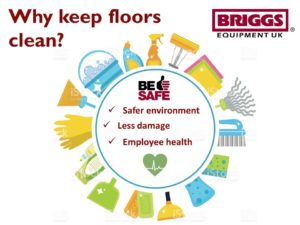Keeping a tidy work environment reduces safety hazards, but leaving debris on the floor can also cause unnecessary damage to any equipment that drives over it, combined with the infiltration of  airborne dust into equipment radiators and air filters which can result in a costly maintenance schedule. Damage to expensive equipment isn’t the only source of issues from airborne dust. Long term exposure for employees can have equally damaging implications for employers as injuries do. Both are situations that could be easily avoided by maintaining some simple floor care routines.
airborne dust into equipment radiators and air filters which can result in a costly maintenance schedule. Damage to expensive equipment isn’t the only source of issues from airborne dust. Long term exposure for employees can have equally damaging implications for employers as injuries do. Both are situations that could be easily avoided by maintaining some simple floor care routines.
Floor cleaning is optimal when carried out over two stages; sweeping the floor to remove debris and loose dust, followed by scrubbing and drying which will help to avoid the ingress of any stains and ensure the floor is not a slip hazard for the period after it has been cleaned. A vacuum sweeper will remove and collect loose debris and dust, and some machines will even remove large debris such as pieces of pallet and brick from external areas. A scrubber-dryer will apply a mixture of water and an appropriate cleaning agent to the floor, utilise scrubbing tool attachments to remove any stubborn dirt, and then vacuum up the waste water with a squeegee and hold it in the machine until you are ready to discard it in a safe place.
It is important to understand the fundamental differences between sweeping and scrubber drying, as they do different jobs and both elements of the cleaning process should be performed to achieve satisfactory results.
The machine you choose is dependent on the area you wish to clean. You may find a pedestrian operated machine may be sufficient, however, if you have a larger surface area, you may opt for a ride on machine, allowing you to cover a greater area with ease.
There are a great number of variables in cleaning pads, brushes and detergents to ensure suitability for every type of surface and depth of clean. From routine cleaning with very soft abrasion, to deep cleaning with harsher chemicals and a more abrasive pad, the versatility of attachments available means you can clean all areas from glazed tiled surfaces, to asphalt concrete, to dimpled rubber floors. Remember, the purpose of cleaning is to preserve value and prevent damage, therefore you should only use the amount of chemicals and mechanical work as necessary to do the job and no more.
Whether you have the resources to manage cleaning tasks in-house with dedicated or rotating resource or you choose to outsource cleaning to a contractor, you can be sure that there are appropriate options available to suit your unique environment.
As the market changes and develops, cleaning equipment is now more widely available through short term hire to suit your needs and budget. When asset management specialist Briggs Equipment was announced as the national dealer for the Hako Machines Ltd range of cleaning equipment in the UK, this brought with it a number of benefits including the availability of equipment on short term hire. With a team of 600 mobile engineers, an in-house finance company and experience supporting organisations with varied fleets of machinery, the ease of sourcing and maintaining equipment is now greater than ever. In addition, a site survey will be carried out for all new customers to ensure that the right products are specified for the environment, removing any guess work and making the sourcing process as easy as possible.
To enquire about how Briggs can help you solve your cleaning and maintenance requirements, just speak to your local sales rep or call us on 03301 23 98 50.